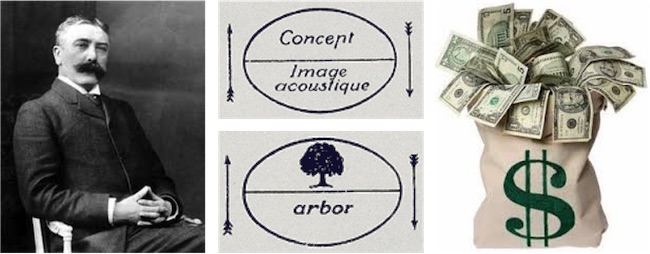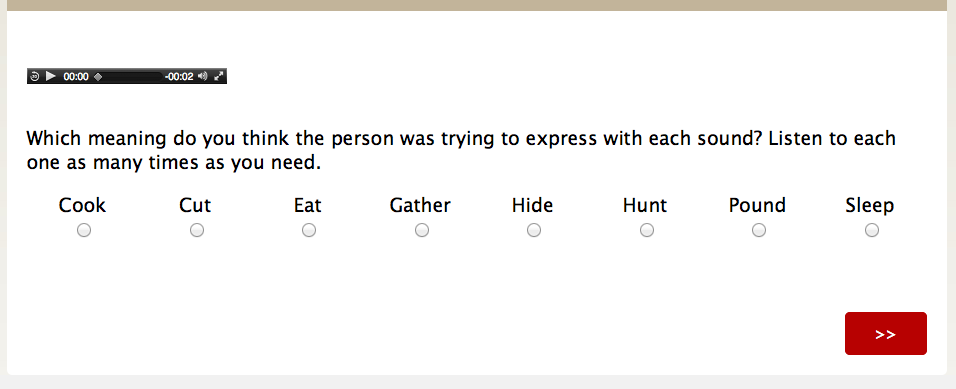Put your communication skills to the test and compete for the $1000 Saussure Prize. Do you have what it takes to become the Vocal Iconicity Champion?
Thank you for your submissions! We have gotten in touch with the winner!
Aim of the game. Devise a system of vocalizations to communicate a set of Paleolithic-relevant meanings. Your vocalizations will be tested by the ability of naïve listeners to successfully guess their meaning from a list of alternatives. The team whose vocalizations are guessed most accurately will be crowned Vocal Iconicity Champion! and winner of the $1000 Saussure Prize.
Meanings. Teams will devise vocalizations to communicate 30 Paleolithic-relevant meanings, divided into three semantic classes – actions (8 items), animate and inanimate things (12), and properties (10).
Actions: eat, cook, sleep, gather, hunt, hide, cut, pound
Things: man, woman, child, snake, tiger, deer, meat, water, fruit, rock, knife, fire
Properties: good, bad, big, small, sharp, dull, one, many, this, that
Procedure and Submission. Teams should submit separate vocalizations for each of the 30 meanings in a .zip file emailed to mperlman@wisc.edu with the subject line “vocal iconicity challenge”. The deadline for submission is July 15, 2015. Each vocalization should be recorded in mono as a single .wav file. The file name should include a distinguishing team prefix, followed by an underscore and the intended meaning (e.g. msp_fruit.wav, where ‘msp’ are initials and ‘fruit’ is the meaning). Each vocalization has to be 2 seconds or shorter in length. Please insert approximately 0.5 seconds silence at the beginning and end of each vocalization, and record with as little background noise and echo as possible. Along with your submission, please submit a text file with a statement of rationale used in the creation of each sound. This file should include the file name of each sound with at least a brief statement of explanation for each (or more if you like).
Vocalizations must be produced by the vocal apparatus of a human team member. For example, you may not use recordings from the Internet, nor may you record your barking dog, even after you have cleverly included him on your team.
Evaluation. Vocalizations will be tested in two phases of evaluation conducted with naïve listeners on Amazon Mechanical Turk. Each team’s vocalizations will initially be evaluated in a within-category test, with actions, things, and properties tested separately. Turkers will listen to the vocalizations created by a team for a particular category and guess the meaning of each one from all of the items within the category. They will only listen to the vocalizations of a single team. We will obtain responses from at least 10 individuals for each vocalization.
The accuracy of each vocalization within a semantic category will be averaged together to determine an accuracy score for each category. The three category scores will then be added together for the team’s total score in the initial evaluation phase.
Total Score = Accuracyactions + Accuracythings + Accuracyproperties
Only the top five teams from the initial evaluation will participate in the second evaluation phase, in which their vocalizations will be subjected to Turkers in a between-category test (i.e. things, actions and properties mixed). All 30 vocalizations will be tested in 3 mixed batches of 10, with the 10 corresponding options. Again, each vocalization will be tested with 10 Turkers. The particular make-up of the three mixed batches will not be revealed before submission, but will be the same for each team. The accuracy of all 30 vocalizations in the between-category test will be averaged together for a total between-category score, and the team with the highest score will be deemed the winner.
The “No Words” rule. Please do not devise vocalizations that match the surface qualities of real words or other conventional vocalizations (i.e., vocal emblems). Vocal emblems specifically include vocalizations like “booo” (as in bad), “yeah” (good), “nyam nyam” (eat), “roar” (the sound of a tiger), “ssss” (the sound of a snake), “mmm hmm” (affirmation), or “mm mm” (disagreement). Vocalizations that are determined to sound like a distinct word or emblem will receive a score of 0. To screen vocalizations, two judges will independently listen to each one with an ear towards hearing words and emblems. If both judges believe they hear a word or emblem, and if it is the same word or emblem (or obviously similar words or emblems), then that vocalization will receive a score of 0.
The Winner. The team that receives the highest score in the second evaluation phase will be crowned Vocal Iconicity Champion! and awarded the Saussure Prize of $1000. The winner will be announced at the Protolang 4 conference, which will take place September 24-26, 2015 (http://protolang.org/)

